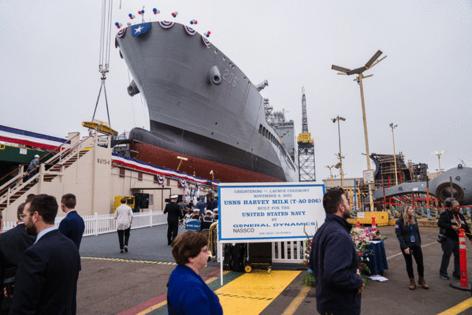Trump defense chief to rename Navy ship -- is that common? Historians weigh in
Published in News & Features
President Donald Trump’s administration is planning to rename a U.S. Navy ship. Is this a common practice?
Secretary of Defense Pete Hegseth is set to rebrand the USNS Harvey Milk, a fleet replenishment oiler named after the California politician and Navy veteran, according to CBS News. Other news outlets have confirmed the report.
Milk served on the San Francisco Board of Supervisors — becoming one of the first openly gay elected officials in the country — before his assassination in 1978.
When asked to comment on the report, a Pentagon spokesperson told CBS News that Hegseth “is committed to ensuring that the names attached to all DOD installations and assets are reflective of the Commander-in-Chief’s priorities, our nation’s history, and the warrior ethos.”
The defense secretary, a former Fox News anchor, has made some negative remarks about LGBTQ people in the past. In his 2024 book, he wrote that policies permitting gay individuals to serve in the military are “part of a ‘Marxist’ agenda,” according to The Guardian.
Hegseth is also no stranger to rebranding military assets. He previously ordered the renaming of North Carolina’s Fort Liberty to Fort Bragg and Georgia’s Fort Moore to Fort Benning — restoring their original names, which were associated with the Confederate generals Braxton Bragg and Henry Benning. But, defense officials noted that the restored names now honor World War II solider Roland Bragg and World War I solider Fred Benning.
Naval historians told McClatchy News that the U.S. Navy has a fairly long history of rebranding existing vessels — particularly in the distant past — but they stressed that renaming ships explicitly for ideological reasons has little precedent.
Long history of renaming ships
“Historically, renaming U.S. warships has been very common,” John Beeler, a history professor at the University of Alabama, who researches military and naval history, told McClatchy News.
He cited the example of the USS New York, an armored cruiser built in 1893, which was rebranded to the USS Rochester in 1917, the year the U.S. entered World War I.
There were a number of reasons existing vessels might have had their names switched.
For one, they could have been renamed after their role in the Navy changed, or after their capture during wartime, Jason Smith, a history professor at Southern Connecticut State University, who researches maritime history, told McClatchy News.
“At other times, naval vessels have been renamed when a newly commissioned ship was slated to be given the preexisting name, which necessitated renaming the older vessel,” Smith said.
David Winkler, a professor at the Naval War College, echoed this view.
“At the turn of the century the Navy named a bunch of armored cruisers for states,” Winkler told McClatchy News. “When we started building battleships, such as the Pennsylvania, California, and Washington, the cruisers having those names became the Pittsburgh, San Diego, and Seattle.”
Further, during the second world war, the escort carrier Midway was restyled as the St. Lo in 1994, allowing a larger battle carrier to take the name Midway.
Winkler noted that, “lore has it that getting your ship name changed is a sign of bad luck,” as the “St. Lo would be sunk at the Battle of Leyte Gulf.”
And, in recent decades, ship renamings have become more rare, he said.
A spokesperson for the Defense Department did not respond to a request for comment from McClatchy News.
The Navy enters ‘the culture wars’
But, despite the Navy’s history of rebranding commissioned vessels, the Trump administration appears to be venturing into somewhat uncharted waters, historians said.
“What is not common is renaming ships for overtly ideological reasons,” Beeler said.
Smith reinforced this view, saying that “renaming ships for political reasons has been virtually unheard of until recently.”
He noted that the sole precedent is the renaming of the the USS Chancelorville and USNS Maury — both styled after Confederate figures — which occurred in 2023, during former President Joe Biden’s tenure. These renamings came at the recommendation of a congressional commission established in the wake of the killing of George Floyd.
One vessel was renamed the USS Robert Smalls after a former slave who aided the Union in the Civil War, and the other was restyled the USNS Marie Tharp in honor of a ground-breaking oceanographic cartographer, according to The New York Times.
Now, the renaming of the USNS Harvey Milk could further cement this new practice of recasting vessels for political reasons, experts said.
And, the Milk may only be the beginning. CBS News reported that numerous other ships could see their names changed. Among those on a “recommended list” are the USNS Harriet Tubman, USNS Ruth Bader Ginsburg, USNS Cesar Chavez and USNS Thurgood Marshall.
“The Navy and its ships have entered — somewhat begrudgingly, I think — into the culture wars along with so many aspects of American public life today,” Smith said.
_____
©2025 The Charlotte Observer. Visit charlotteobserver.com. Distributed by Tribune Content Agency, LLC.







Comments